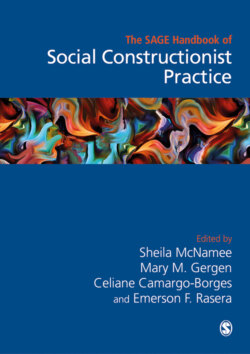Читать книгу The Sage Handbook of Social Constructionist Practice - Группа авторов - Страница 80
На сайте Литреса книга снята с продажи.
Attractions of Performative Inquiry
ОглавлениеAs we see, the constructionist dialogues provide strong arguments for social scientists to cast off the restrictions of positivist methodology, to give expression to their values in the aims and practices of their research, and to employ the full range of rhetorical skills in communicating their work. For those engaged in these dialogues, there was the additional advantage that performative inquiry avoided the kind of authoritative truth claims often associated with scientific rhetoric. When a message is carried through performance, an audience may be moved without presuming that it is scientifically certified. Performative work constitutes serious play.
Whether touched directly or indirectly by constructionist dialogues, social scientists have found performative inquiry appealing in many other ways. At the outset, such inquiry allows the researcher to address social concerns in ways that are far more accessible to public audiences than are the more antiseptic and abstract forms of professional writing (Finley, 2018). This also allows the researcher to avoid the common critique that scholarly work is elitist, that it is written for other scholars, while the public is shut out of the conversation that is often ‘about them.’
Also attractive is the invitation to personal expression. The researcher is not hamstrung by a cumbersome and formalized language of representation, as required in many scientific communities, but can draw from the full range of his or her potentials. This may mean, for example, drawing from folk traditions in one's life – woven into one's ethnicity, gender, or class. In a recent edition of the International Review of Qualitative Research, for example, one article features Anishinabe song and story (Pedri-Spade, 2016) and a second the craft of beading as a method of performative inquiry (Ray, 2016).
In contrast to traditional methods – in which one's life history is eliminated from view, a performative orientation also opens a space in which one's life experiences can become assets to expression. We shall return to this potential in a later discussion of autoethnography. And too, performative inquiry invites the researcher to explore or give expression to one's aesthetic potentials – in writing poetry, acting, playing an instrument, dancing, and so on.
Many researchers are attracted to performative inquiry because of its rhetorical power. Among the attributes of performative inquiry are its capacity to blend various forms of art together, thus ‘speaking in many voices’ at once. For example, in his analysis of Custer's ‘last stand’ against native American warriors, Norman Denzin combined autobiographical reminiscences, historical description, artistic representations, staged readings, and snippets of documents to produce a powerful, multi-layered ethnography (2011). This feature is especially attractive to activist researchers. While lines of careful reasoning may advocate social change, their temperate and measured form of logical argumentation often leave one in thought. Are there other arguments to consider; what is the history of this issue; and so on. By drawing on the full range of the arts, one's message can stimulate excitement, the emotions, and the impetus to action.
